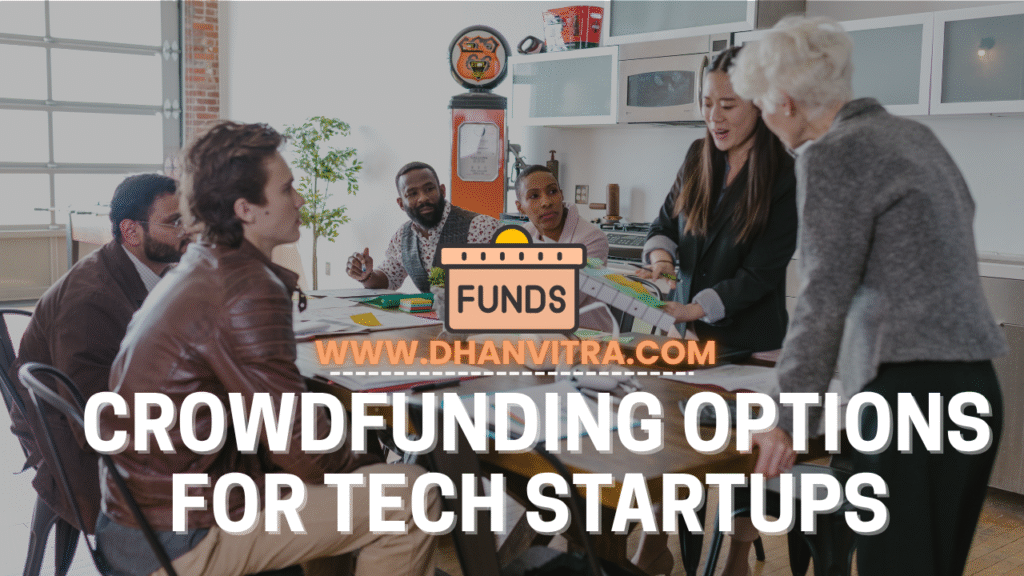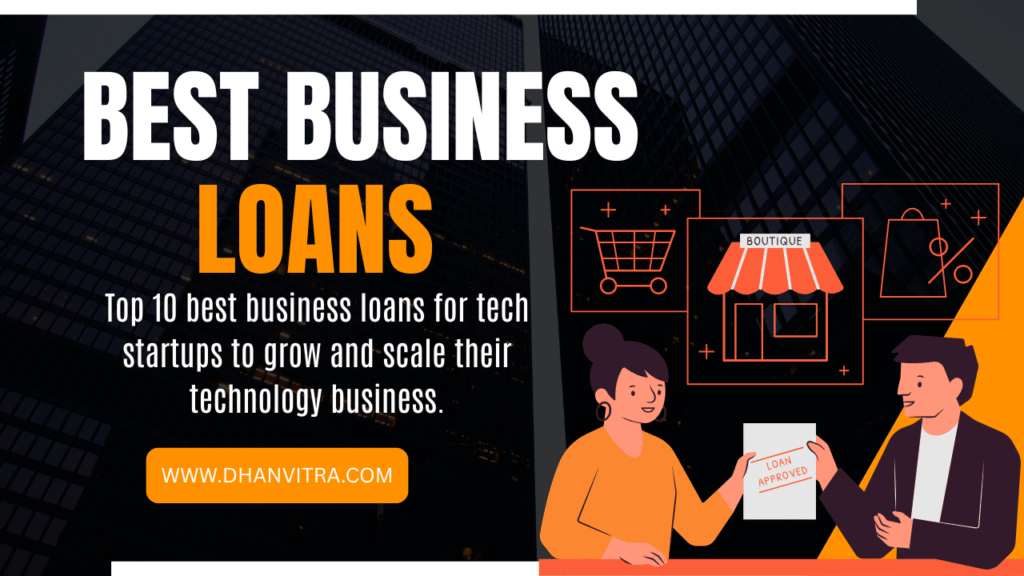
Hey there! Welcome to Dhanvitra, your go-to space for everything money, innovation, and growth. If you’ve ever dreamed of creating a tech product but got stuck wondering “Where do I get the funds?” — you’re in the right place.
Today, we’re diving into a game-changing topic — “Crowdfunding Options for Tech Product Development: 9 Shocking Facts You Must Know.”
At Dhanvitra, we believe in simplifying finance for creators, dreamers, and entrepreneurs like you. Whether you’re building a smart home gadget, a health tech app, or the next AI-powered device, funding should never stop your idea from becoming real.
Let’s face it — traditional funding options like bank loans and venture capital can feel like closed doors. That’s where crowdfunding for tech startups flips the script. It’s flexible, global, and, most importantly, fair.
In this blog, we’ll walk you through everything — from how crowdfunding works, the types of crowdfunding, to real-world insights that most people don’t talk about. You’ll also uncover 9 shocking facts about crowdfunding that can literally change how you approach product development in 2025 and beyond.
Our goal? To help you make smarter financial choices for your tech ideas — with zero jargon and 100% practical advice.
So grab your coffee, sit back, and let’s explore how crowdfunding platforms like Kickstarter, Indiegogo, and SeedInvest are redefining the future of tech funding — one idea at a time.
Stay tuned, because the next section will break down exactly what crowdfunding is and why it’s becoming the backbone of tech innovation worldwide.
Crowdfunding Options for Tech Product Development
Crowdfunding has become a global movement that gives power back to creators. It’s no longer just about asking for money. It’s about building trust, excitement, and a loyal fanbase before your product even hits the market.
When it comes to tech product development, crowdfunding bridges the gap between a great idea and a finished product. Imagine you’ve created a smart wearable, a drone, or an AI-powered gadget. Before you spend thousands on production, you can test how much people actually want it. Crowdfunding platforms allow you to present your concept, showcase a prototype, and get people to pledge support — all online.
Unlike traditional funding methods, where investors demand equity or control, crowdfunding keeps you in charge. You decide the goals, rewards, and campaign story. This independence makes crowdfunding a game-changer for startups, small businesses, and solo tech innovators.
It also acts as a real-time validation tool. When backers invest, they’re not just funding an idea — they’re confirming there’s real market demand. This instant feedback helps you adjust your design, features, or pricing before mass production begins. In other words, crowdfunding doesn’t just raise money — it reduces the risk of launching a product nobody wants.
Globally, crowdfunding is now a $100+ billion industry. For tech developers, it’s more than just financial support — it’s a launchpad to visibility, credibility, and global market reach.
Types of Crowdfunding for Tech Products
Reward-Based Crowdfunding
Reward-based crowdfunding is the most popular choice among tech creators. Here, backers support your project in exchange for exclusive rewards — usually your product itself, early access, or limited-edition features. Platforms like Kickstarter and Indiegogo have made this model famous.
For example, imagine launching a smart speaker that uses AI to learn your voice. Early backers could get the device at a discounted rate before it hits stores. It’s a win-win — you get the funds to build your dream product, and they get to feel like part of your innovation journey.
The key here is storytelling. If people believe in your vision, they’ll invest not just in your product but in your passion.
Equity-Based Crowdfunding
Equity crowdfunding is ideal for startups ready to grow. Instead of offering rewards, you give investors a small share of your company. Think of it like having mini-investors from around the world who believe in your tech vision.
Platforms such as SeedInvest, Wefunder, and Crowdcube make this model easy to access. If you’re developing a scalable tech product — like an IoT platform or a renewable energy device — equity crowdfunding can bring in not just funds but long-term partners who want you to succeed.
It’s also a great way to attract venture capital later since equity campaigns show that people are confident in your business model.
Donation-Based Crowdfunding
Donation-based crowdfunding focuses on goodwill. It’s perfect for tech projects aimed at social impact — like developing low-cost health devices, educational apps, or clean energy tech for rural areas.
People donate because they believe in your mission, not because they expect a return. Platforms like GoFundMe work well for these causes. This type of funding reminds us that technology can serve humanity, not just profit margins.
Debt-Based Crowdfunding
Also known as peer-to-peer (P2P) lending, this model lets backers lend money to your business. You agree to repay the amount with interest over time.
It’s a great option for startups that already have some traction but need extra funds to scale production. Unlike banks, P2P lenders are faster, more flexible, and often more supportive of innovation.
Top Crowdfunding Platforms for Tech Startups
Kickstarter
Kickstarter is the giant of crowdfunding. Since its launch, it has helped creators raise billions for innovative tech projects. Whether you’re building a new robot, drone, or VR device, Kickstarter gives you global visibility. The platform values creativity and originality — if your idea is fresh and well-presented, backers will notice.
One secret to success on Kickstarter is visuals. A high-quality video showing your prototype, mission, and passion can make your campaign go viral overnight.
Indiegogo
If you want more flexibility, Indiegogo might be your best friend. Unlike Kickstarter, it allows you to keep the funds raised even if you don’t reach your target goal. That’s great for early-stage startups experimenting with new tech ideas.
Indiegogo also has a global reach, so you can attract backers from anywhere. Plus, it offers post-campaign support through InDemand, allowing you to keep selling your product long after the campaign ends.
GoFundMe
GoFundMe is perfect for socially driven tech innovations — think environmental tech or accessibility gadgets. It focuses on storytelling and emotional appeal. You don’t need fancy marketing; you just need to connect with your audience on a human level.
People who donate here want to make a difference. If your tech has a positive social impact, GoFundMe can help you find passionate supporters.
Crowdcube
Crowdcube specializes in equity crowdfunding. It’s mainly popular in Europe but attracts global investors. Tech startups love it because it connects them directly to serious investors who understand technology.
It’s ideal for founders who want to raise larger amounts without going through the long, complex venture capital route.
SeedInvest
SeedInvest focuses on high-potential startups. It’s selective but powerful. If your product shows strong innovation, a clear market need, and a skilled team, SeedInvest can bring in investors who are genuinely interested in long-term growth.
Tech founders appreciate that it also provides legal and financial guidance throughout the process — a huge plus if you’re raising equity for the first time.
1. Most Tech Campaigns Fail Before Reaching 20% Funding
It’s true — many campaigns don’t reach their targets. The reason? Lack of planning. Successful campaigns spend weeks preparing, testing their message, and building anticipation before launch.
9 Shocking Facts About Crowdfunding in Tech Product Development
2. Visual Storytelling Boosts Funding by 60%
People connect with visuals more quickly than with words. A clear, emotionally engaging video can multiply your funding chances. Backers want to see your prototype, your face, and your passion.
3. 80% of Backers Expect Weekly Updates
Transparency matters. If you don’t keep your backers updated, they lose trust. Regular updates build excitement and show commitment.
4. Crowdfunding Validates Market Demand Instantly
When people back your project, they’re proving that the market wants it. This early validation is gold — it saves you from wasting time and money on ideas that won’t sell.
5. Early Bird Rewards Drive 70% of Pledges
Limited-time offers trigger urgency. When you reward early backers with discounts or exclusive perks, it motivates quick action — a proven psychological effect in marketing.
6. Poor Video Quality Reduces Success Chances by 45%
Campaigns with low-quality videos often fail to build trust. People judge your professionalism through presentation, not just your product.
7. Influencer Marketing Drives 50% of Successful Campaigns
Collaborating with tech influencers can significantly boost visibility. When credible voices endorse your product, backers feel confident joining in.
8. Equity Crowdfunding Is Growing 10x Faster in 2025
The demand for equity-based campaigns is exploding. Investors want a piece of the next big innovation. This trend shows that crowdfunding is becoming mainstream for startup funding.
9. Many Startups Secure VC Funding After Crowdfunding
Crowdfunding success can attract venture capitalists. It proves your product’s viability and builds an audience — both key factors for investors looking for promising startups.
How to Choose the Best Platform for Your Tech Idea
Choosing the right crowdfunding platform can make or break your tech journey. Think of it like picking the right launchpad for your rocket — one wrong move, and your dream idea might never take off. Each platform has its own audience, funding model, and success rate.
Start by asking yourself what your ultimate goal is. Do you want to raise funds fast, or are you looking for long-term investors? For example, if you’re developing a smart gadget or hardware product, Kickstarter is often the go-to platform because it’s built around product-based innovation. It’s reward-driven and attracts backers who love new tech toys.
On the other hand, Indiegogo offers more flexibility. It supports both fixed and flexible funding, meaning you can still keep your funds even if you don’t reach your full goal. This is perfect if your tech project can still move forward with partial funding.
If your idea is more investment-oriented, equity crowdfunding sites like Crowdcube or SeedInvest are worth exploring. They connect startups directly with investors who believe in the product and want a share of your success.
Also, consider the fees each platform charges. Some take around 5–8% of your total funds, which might not sound much initially, but it adds up. Finally, analyze the audience. For global reach and exposure, platforms like Kickstarter and Indiegogo have international appeal. But if you’re targeting regional investors, local platforms might give you better traction.
In short, your crowdfunding platform should align with your vision, target audience, and funding strategy — not just popularity.
Steps to Launch a Successful Crowdfunding Campaign
Launching a successful crowdfunding campaign isn’t luck; it’s strategy. It’s like building a house — without a solid foundation, it collapses. Let’s break down the process in a way that actually works.
Step 1: Define Your Goal and Budget
Be crystal clear about how much money you need and what it’s for. Don’t just throw in random numbers. Backers love transparency, so explain how each dollar will help develop, test, and launch your product.
Step 2: Craft a Powerful Story
Share your journey. Why did you start this tech idea? What problem are you solving? A compelling story builds emotional connection and trust. Add visuals, a prototype video, and behind-the-scenes shots to make it more relatable.
Step 3: Create a Prototype
Don’t wait for perfection. Show a working prototype that proves your concept is real. It boosts your credibility and helps backers visualize your final product.
Step 4: Plan Your Marketing Strategy
Even the best tech idea fails without proper marketing. Use social media, email campaigns, and influencer collaborations to spread the word. Warm up your audience before you launch — that early buzz often decides how far your campaign goes.
Step 5: Engage with Your Backers
Once your campaign is live, stay active. Post updates, reply to comments, and thank your supporters. People love seeing progress. That engagement keeps the momentum going and builds a loyal fan base even after funding closes.
Launching a campaign is like running a marathon — preparation, consistency, and connection are everything.
Mistakes to Avoid in Tech Crowdfunding
Let’s be real — most crowdfunding campaigns fail not because of bad ideas, but because of bad execution. Avoiding common mistakes can save you time, money, and stress.
The biggest one? Lack of transparency. Backers want honesty. If there’s a delay in shipping or development, communicate openly. Silence kills trust faster than failure.
Another common pitfall is overpromising. Don’t claim your AI gadget will change the world if you can’t deliver it on time or within budget. It’s better to promise less and surprise your supporters later.
Then comes poor presentation. Low-quality images, vague descriptions, or a boring pitch video can ruin first impressions. Remember, people are visual learners. Make your campaign page clean, energetic, and professional.
Lastly, never ignore your community feedback. Some creators disappear once they get funded, which backfires badly. Listen to your backers — they’re your first customers and biggest advocates.
Avoid these mistakes, and you’ll build not just a successful campaign but a loyal tech community that believes in your vision.
How Crowdfunding Can Boost Tech Innovation
Crowdfunding isn’t just about raising funds — it’s a powerful innovation engine that fuels creativity across the tech world. It levels the playing field by giving independent creators the same exposure once reserved for big corporations.
When you crowdfund, you’re not pitching to a boardroom — you’re talking directly to people who love tech as much as you do. This open connection brings real-time feedback. You get insights on what users want, what features excite them, and what concerns they have — long before the official launch.
Crowdfunding also helps in market validation. Imagine building a product that already has hundreds or thousands of pre-orders before hitting the shelves. That’s proof your idea works. Investors notice that too. Many venture capitalists now track crowdfunding platforms to spot promising startups that have already built community trust.
Moreover, crowdfunding pushes creators to be more transparent, creative, and user-focused. You can’t just drop an idea — you need to show progress, test prototypes, and refine designs based on community response. It turns tech development into a collaborative process where users help shape the final product.
In essence, crowdfunding has become the heartbeat of modern innovation — transforming garage ideas into global tech brands. It’s no longer just a funding tool; it’s a movement that empowers dreamers to turn code, circuits, and imagination into reality.
The Future of Crowdfunding in the Tech Industry
The future of crowdfunding in the tech world looks brighter than ever. As innovation keeps accelerating, more creators are turning to the crowd to fund their bold ideas. The traditional venture capital route often feels like a closed door — slow, selective, and full of conditions. Crowdfunding flips that script. It opens doors for anyone with an internet connection and a dream.
Technology itself is reshaping how crowdfunding works. Blockchain is one big player here. It brings transparency, security, and trust — the three things that backers crave. Imagine being able to track every single dollar through a blockchain ledger. That’s not just innovation; it’s empowerment.
Artificial Intelligence is another game changer. AI helps creators target the right audience, optimize campaigns, and predict funding success before launch. It’s like having a smart assistant that tells you, “Hey, this campaign title will grab more attention,” or “Post your video at 6 PM for maximum engagement.”
We’re also seeing a rise in micro-investments. People don’t need to be millionaires to invest in tech anymore. Even $10 contributions can make a real difference. It’s a world where everyone, from students to professionals, becomes a part of innovation.
Crowdfunding is moving beyond borders, too. Global platforms are now supporting multilingual campaigns and international payments. Whether you’re a coder in India, an engineer in Germany, or a designer in the U.S., you can reach supporters across continents.
The future is global, transparent, and inclusive. Crowdfunding is not just a financial tool anymore — it’s becoming a social movement for tech creativity.
Key Takeaways
Crowdfunding has completely redefined how tech startups launch and grow. It’s no longer about pitching to a few investors in a boardroom. It’s about connecting with thousands of real people who believe in your idea.
The key lesson? Your community is your biggest investor. The stronger your connection with your backers, the higher your chances of success. Tech entrepreneurs must focus on storytelling, honesty, and consistent updates.
Technology is also enhancing how campaigns operate. AI and blockchain are bringing smarter insights, automated marketing, and more secure transactions. The result? Greater trust and higher success rates.
Remember this — crowdfunding isn’t just about money. It’s about building early brand loyalty, validating your product, and setting your business up for long-term growth. The tech products that stand out tomorrow will be those built hand-in-hand with their communities today.
Conclusion
So, where does this all lead? The future of tech product development lies in the hands of creators — and their crowd. Crowdfunding has given power back to innovators. No more waiting for a single investor’s approval. No more endless pitches and rejections.
The new era belongs to dreamers who take action. If you can share your story, show your prototype, and inspire people to believe, you can bring your idea to life. It’s as simple and powerful as that.
Whether you’re building a new wearable gadget, a clean energy device, or the next AI-powered app, crowdfunding gives you the wings to fly. The global tech scene is watching, and your next campaign could be the one that changes everything.
Innovation doesn’t need permission anymore. It just needs passion — and the crowd.
FAQs
What will crowdfunding look like in the next five years?
Crowdfunding will be more intelligent, data-driven, and decentralized. Blockchain and AI will dominate, making the process transparent and predictive. Expect faster campaigns, smart contracts, and more global participation.
Can anyone launch a crowdfunding campaign for a tech product?
Absolutely. Anyone with a strong idea and a solid plan can start. You don’t need to be a big company or have investors. You just need a clear vision, a working prototype, and a story that connects with people.
How can tech startups stand out on crowded platforms?
Focus on storytelling. People fund emotions before they fund logic. Use engaging videos, clear goals, and consistent communication. Be authentic — that’s your biggest advantage.
Are small investors safe in crowdfunding?
Yes, with regulated platforms and blockchain integration, investor safety is improving rapidly. Always use reputable sites and read terms carefully before contributing.
Why should I choose crowdfunding over venture capital?
Crowdfunding gives you creative control and builds an early fan base. Venture capital can bring money, but it often limits flexibility. Crowdfunding lets your customers decide your product’s future — not a single investor.










